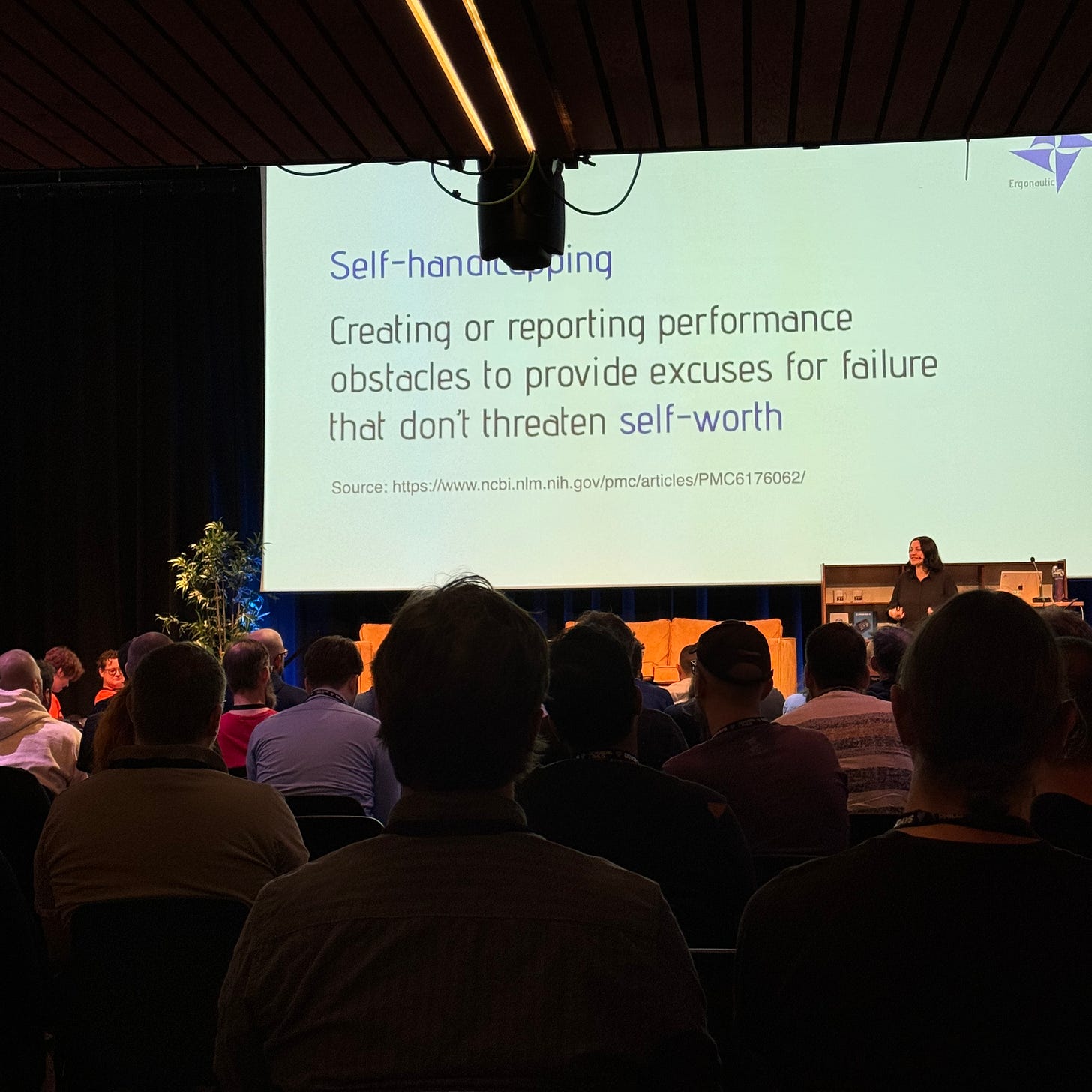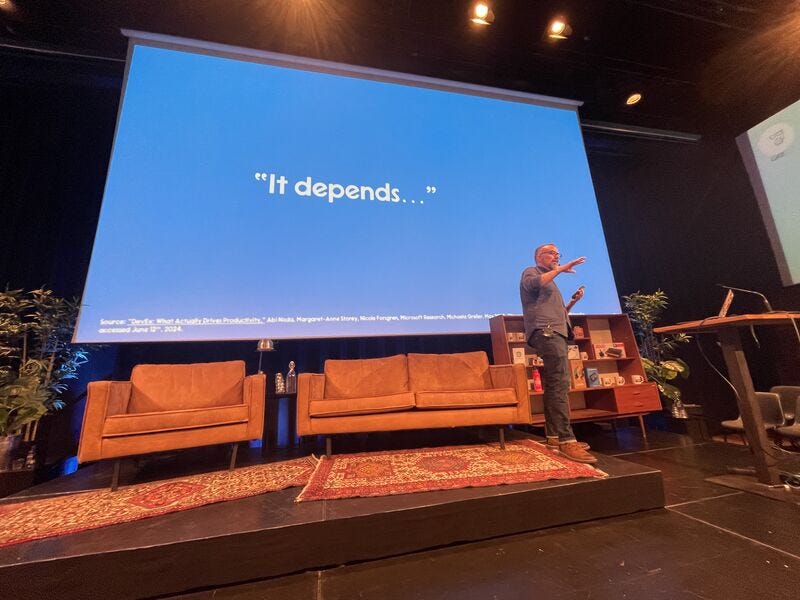Coté
Publishing an annual survey is a great marketing tool, even better for thought-leadership
Using Surveys for Marketing
Wastebook
They dress like they’re Chaotic Good, but they’re totally Lawful Good under all that sloppy couture.
This is some buck-wild ABM: a direct appeal to Delta to buy their AI stuff.
“I wrote this one when my family was in Hawaii, too. I kind of had a meltdown there, to be honest.” Blue Cheese.
If you were to watch Furosia and Fury Road back-to-back, as one movie, it might just be the best action movie ever made. You’d need two intermissions, though, not between the two movies, but right before each major action sequence.
Why Not Give Robots Foot-Eyes? Here.
“How are you today?” “Legally prohibited from complaining due to a non-disparagement clause, you?” Via.
“The problem is the darker side of the word, when we use it to express ‘merely.’” Here.
“nothing fun happens on a Monday night.” Here.
“Unsavory”
“How does (or will) AI impact this decision?” // When AI reaches the office or the CFO. // If your CFO asked this, how would you even answer it? Would a CFO know how to interpret, verify, and trust the answer? // Maybe the right answer is “who knows. Have you actually used those things? How about we put ‘fuck around and find out’ on the ledger for this quarter?”
There’s no fucking around, just finding out.
“Why Not Give Robots Foot-Eyes?” Here.
“It just wasn’t their world anymore. So they had to leave.” Hilda, s1e2.
“There’s that well observed effect where you have better conversations if you’re not looking each other in the eye. Driving. Walking. Walking meetings. Watching telly on the sofa.” Russell Davies.
And: “they still have a selection of newspapers you can read. That means something, they’re not going to hurry you out if they’ve offering you a newspaper.” Ibid.
“How are you today?” “Legally prohibited from complaining due to a non-disparagement clause, you?” Via.
“The problem is the darker side of the word, when we use it to express ‘merely.’” Here.
“A turd for your argument” Here.
Relative to your interests
Platform Engineering: The First Hype Cycle - I should probably read this.
Gartner Survey Shows 66% of Finance Leaders Think Generative AI Will Have Most Immediate Impact on Explaining Forecast and Budget Variances - What’s also remarkable is how low they rate other use cases. I’m a bit confounded about reports that consulting firms are getting billions in sales for AI stuff. What could it possibly be?
A Eulogy for DevOps - “Feels like somehow Developers got stuck with a lot more work and Operation teams now need to learn 600 technologies a week. Surprisingly tech executives didn’t get any additional work with this system. I’m sure the next reorg they’ll chip in more.” // New idea for conference talk: The Nine Lives of DevOps.
Kubernetes Security Report: Evolving Landscape of DevSecOps - Red Hat Kubernetes surveys results, here, looking at the security part. The theory is: there’s too many different parties working on security, causing “confusion and delay.” See also our recent State of Cloud Native Platforms survey (5th year in a row): security is always on the top. I guess that problem will never get solved.
YouTube dominates streaming, forces media companies to adapt - “YouTube made up 9.7% of all viewership on connected and traditional TVs in the U.S. in May — the largest share of TV for a streaming platform ever reported by Nielsen’s monthly ‘The Gauge’ report. Netflix ranked second, claiming 7.6% of viewership. Among streamers only, YouTube’s total viewership was close to 25% market share.”
Don’t be results-oriented - Make sure your factory is functioning well.
Enterprise hits and misses - gen AI spending meets ROI pressure, AI readiness is a thing, and AR/VR has a vision problem - “Enterprise hypothesis: AI can’t fix what ails you (e.g. legacy landscape and ‘messy’ data bottlenecks), but applied properly, it can accelerate what you do well.” // And, as said elsewhere: “So you aren’t just adopting AI, you’re doing data management as well.”
Logoff
Someone finally figured out why procrastination is therapeutic:

New idea for a conference talk: “How platform engineering stole all your sponsorship money.” It’d kill as a lighting/ignite/whatever talk on the DevOpsDays circuit.
It’s July!
A Eulogy for DevOps - “Feels like somehow Developers got stuck with a lot more work and Operation teams now need to learn 600 technologies a week. Surprisingly tech executives didn’t get any additional work with this system. I’m sure the next reorg they’ll chip in more."
Kubernetes Security Report: Evolving Landscape of DevSecOps - Red Hat Kubernetes surveys results, here, looking at the security part. The theory is: there’s too many different parties working on security, causing “confusion and delay."
Gartner Survey Shows 66% of Finance Leaders Think Generative AI Will Have Most Immediate Impact on Explaining Forecast and Budget Variances - What’s also remarkable is how low they rate other use cases. I’m a bit confounded about reports that consulting firms are getting billions in sales in AI stuff.
Don’t be results-oriented - Make sure your factory is functioning well.
What to put in tech marketing newsletters
I’m always telling my marketing friends that they should do more newsletters. They have so many objections and hurdles - mostly self-imposed ones. Here’s why I think they’re good, easy, and how to come up with things to put in them.
What I do with AI, what I've given up on
Consumer-grade Chat Gen-AI Churn Update
Overall, the generative AI things have been a disappointment for me. For writing, they seem helpful for generating and starting content, but it ends up being more work to fix and, then, rewrite what they do. Over the years, people have ghostwritten things for me. Like, humans! I’d too often have to (want to) go through and inject my voice and style, and also add play around with the core ideas. Now, when “byline” opportunities like this come up, I write just write it all myself.
Using AI for writing is like that. It’s sort of good for bouncing off ideas.
And summarizing text is hit or miss. First, it can’t always retrieve web pages. I mean, I get it with people not wanting to give their content to Evil Nerds and stuff. But the result is that I don’t get what I want: a faster way to read text.1 The summaries are “fine,” but they usually tell you what the article is about instead of making the actual contents easier to read.
Should I cancel my subscriptions? I haven’t been able to get my mind around canceling ChatGPT, but I did cancel Gemini.
Gemini just never felt like it was doing more than a quarter-assed job. This was the final deciding factor: I asked it to tell me what my oldest email in GMail was and who wrote it, and it claimed it couldn’t find that, and did something like just telling me the last ten emails in my GMail inbox. I mean, come on: what the actual fuck? And this is when it actually looked at GMail. Often Gemini would tell me it didn’t even have access.
And, I’ve more or less given up on using it to play D&D. It just can’t be creative enough. This one is more complicated to evaluate. If you put a lot of work into it, it sort of works - hence my early enthusiasm. But, it’s like some of the other use cases: it’s only as good as what you bring to the table. Both your time in managing it (crafting prompts, giving it the right text to start with) and coaching it. Instead, you could just all of that yourself.
Now, having it generate code for me works well. But it’s not like I’m writing big enterprise apps. I’m just making one off scripts.
My theory is that it’s just better search, slightly better summarizing. For example, you can upload the endless lore about The Forgotten Realms, and it sort of does good at answering questions for you. It’s also good at explaining things, being a tutor. I had a long session to understand net-present value and discounted cash flows, and I feel like I understand that better. Having it explain why the Fed interest rate is so important would be interesting.
With all of the billions(!) being spent on consultancy firms, I’m not sure…why. CEOs and other executives who’re so thrilled by AI should try actually using it for week, even in just these chat interfaces. If Google can’t search it’s own services like Gmail, good luck to the rest of you.
Here is a picture of my daughter enjoying delicious Dutch fries at the zoo

Wastebook
This meeting could have been an AI talking to itself. At worst, two AIs talking to each other.
“Life in general being more software-mediated.” Sharp Tech, June 20th, 2024. // This is a good framing, and simplification of what “digital transform” aspires to describe.
This meeting could have been an AIs talking to itself.
AI: have the bullshit master do bullshit work. Yes, and: if you can have AI generate it, it’s probably not worth doing.
Socialism applied to developer productivity metrics.
“…the one that you appreciated, which: I appreciate your appreciation.”Sharp Tech, June 20th, 2024s
“There is, what we say, ‘the escape of the brains,’ in Italy.” Sara.
“We’ll have extra slides to explain the bingo to you.” DevOpsDays Amsterdam evening activities.
“Succor borne every minute.” The FTC.
‘Perhaps they have a regex that replaces “Willie Nelson” with “Lavar Burton”?’ Here.
“the Let’s Only Drop Half A Bomb On Belgium Party” NL politics.
Mixed metaphor du jour: festering tech debt.
New number to track: how much of your IT budget is spent on “tech debt” (or “legacy”)? // “CIOs estimated that tech debt amounts to 20 to 40 percent of the value of their entire technology estate before depreciation.” McKinsey in October, 2020.
And: “Some 30 percent of CIOs we surveyed believe that more than 20 percent of their technical budget ostensibly dedicated to new products is diverted to resolving issues related to tech debt.” Ibid.
“lift-tinker-and-shift.” Stephen Orban, AWS, 2016.
Do you self identify with these sales plays? If so, dial 1–800-CUSTMRJRNY right now. Call now!
“Fake Buddha Quote.” Here.
“The median image could be described as ‘a poster you’d expect to see on the wall of a teenage boy in a movie scene where the writers are reaching for the standard stock props to show that the character is a horny teenage boy who has poor social skills.’” On AI images.
“Next: cranium rats.”
Maybe there’s a rubric that: if it takes more than a day to be delivered and to your house, it’s actually a luxury good.
“He always carried a little grater and a nutmeg to flavor the glasses of port he drank.” On Henri de Toulouse-Lautrec.
“In fact, XML is possibly the only announcement in the development world to rival the impact of the Java platform. It is fortunate for us as developers that these are complementary technologies rather than competing ones.” June, 2000.
AI is the enemy of done.
Any person at a vendor who’s actually worked on the submission to a Wave or Magic Quadrant will tell you: if we COULD have paid them instead of doing all this work, we WOULd gladly have paid them, even out of our own wallets.
AI Will Not Fix Your Broken Culture (and Other Hard Truths).
“Reduced Snowflake expenses by 50% by clicking a button that I am pretty sure that 90% of companies also need to click. A$500,000 savings, approximately.” Here. A resume is as much about filtering out potential employers as it is the recruiting pipeline.
“geomyth” Here.
They really wear their strategy on their sleeve.
“The second thing I do is decide whether the country is worth wasting a meal on breakfast. I might just skip it.” Tyler.
And: I hate to be the grumpy old man but one day, not too long from now, I will be telling my children, “I remember when you didn’t need a visa to travel abroad. I also remember when there were no anti-money laundering and know your customer laws!” The kids probably won’t believe me.
“Are we up to 7 “R’s” now?” // it feels like there are only seven people who will get this joke, and I know ow three of them. From Seroter.
“Many prey animals will have no coherent image of what their greatest predator actually is” Here.
Logoff
I feel like I’ve been busy, in a hectic state for awhile. But I’m not sure what I’ve done. Trying to look at it objectively, over the past two weeks I’ve (1) given a talk at DevOpsDays Amsterdam, (2) written 90% of an article about one of our recent surveys, (3) edited a co-workers first-ish blog post, (4) filed some expenses,2 (5) polished up my resume,3 and (6) done all the usual family stuff. This is actually a lot of work! But, it still feels like not enough. Anything that does not result in publishing, and then acclaim (or at least more than a handful of feedback) feels like “not working.”
I don’t know what that is. It’s not imposter syndrome or something from the bag of DevOps pop-psycology. I don’t think it’s, like, lack of GTD’ing or any kind of nudges-habits airport book lore. It’s weird, and unsatisfying.
I was also thinking you could make a script that launders it through archive.ph, or just some simple curl thing if I knew how to setup, I don’t know, a GitHub Action? Is that what the kids do nowadays? Maybe a Tailscale port into my [yet to exist] home network raspberry pie cluster? Jesus. Just get me the text of the web page so I can get on with my life.
We switched from Concur + Amex to Workday for expenses. It’s much more time consuming, so I consider it a sort of “deliverable.” You know an enterprise app is bad when it makes you long for Concur. That’s a slight to Concur, but actually, it’s a good piece of software. What makes it good is that you can tell the teams working on it actually pay attention to the user, how they file expenses and all of the micro options that add up to hassle. The ultimate expenses filing use case is filing expenses for a 3+ night hotel stay where you’re charged something different each night. That also makes the various taxes you pay different each day. Throw in parking and different amounts for extras like meals, and you’ve got yourself a fantastic use case for filing expenses. My theory is that most people don’t like Concur because (1) filing expenses is dull, not matter how well it’s done, and, (2) company policies are usually annoying and tedious: anytime you have to deal with your corporate culture through policy instead of human interaction is infantilizing. It’s like getting a little pat on the head and being told, “oh, honey, bless your heart. You need to fill in the comment field and tell me why you used a non-standard rental car company.”
In this economy, one never knows when that might come in handy. Inquire if you’re like to see it.
Enterprise hits and misses - gen AI spending meets ROI pressure, AI readiness is a thing, and AR/VR has a vision problem - “Enterprise hypothesis: AI can’t fix what ails you (e.g. legacy landscape and ‘messy’ data bottlenecks), but applied properly, it can accelerate what you do well."
How Much Revenue Must a Company Generate to IPO? - “Before 2018, only one company IPOed with more than $200m in revenue. In fact, the median revenue at IPO at $90m. Today, the median revenue at IPO is $189m (corrected for inflation), more than double."
YouTube dominates streaming, forces media companies to adapt - ’YouTube made up 9.7% of all viewership on connected and traditional TVs in the U.S. in May — the largest share of TV for a streaming platform ever reported by Nielsen’s monthly “The Gauge” report. Netflix ranked second, claiming 7.6% of viewership. Among streamers only, YouTube’s total viewership was close to 25% market share.'
